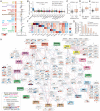C16orf72/HAPSTR1 is a molecular rheostat in an integrated network of stress response pathways
- PMID: 35776542
- PMCID: PMC9271168
- DOI: 10.1073/pnas.2111262119
C16orf72/HAPSTR1 is a molecular rheostat in an integrated network of stress response pathways
Abstract
All cells contain specialized signaling pathways that enable adaptation to specific molecular stressors. Yet, whether these pathways are centrally regulated in complex physiological stress states remains unclear. Using genome-scale fitness screening data, we quantified the stress phenotype of 739 cancer cell lines, each representing a unique combination of intrinsic tumor stresses. Integrating dependency and stress perturbation transcriptomic data, we illuminated a network of genes with vital functions spanning diverse stress contexts. Analyses for central regulators of this network nominated C16orf72/HAPSTR1, an evolutionarily ancient gene critical for the fitness of cells reliant on multiple stress response pathways. We found that HAPSTR1 plays a pleiotropic role in cellular stress signaling, functioning to titrate various specialized cell-autonomous and paracrine stress response programs. This function, while dispensable to unstressed cells and nematodes, is essential for resilience in the presence of stressors ranging from DNA damage to starvation and proteotoxicity. Mechanistically, diverse stresses induce HAPSTR1, which encodes a protein expressed as two equally abundant isoforms. Perfectly conserved residues in a domain shared between HAPSTR1 isoforms mediate oligomerization and binding to the ubiquitin ligase HUWE1. We show that HUWE1 is a required cofactor for HAPSTR1 to control stress signaling and that, in turn, HUWE1 feeds back to ubiquitinate and destabilize HAPSTR1. Altogether, we propose that HAPSTR1 is a central rheostat in a network of pathways responsible for cellular adaptability, the modulation of which may have broad utility in human disease.
Keywords: network; signaling; stress.
Conflict of interest statement
The authors declare no competing interest.
Figures







References
-
- Galluzzi L., Yamazaki T., Kroemer G., Linking cellular stress responses to systemic homeostasis. Nat. Rev. Mol. Cell Biol. 19, 731–745 (2018). - PubMed
Publication types
MeSH terms
Substances
Grants and funding
LinkOut - more resources
Full Text Sources
Molecular Biology Databases
Miscellaneous

